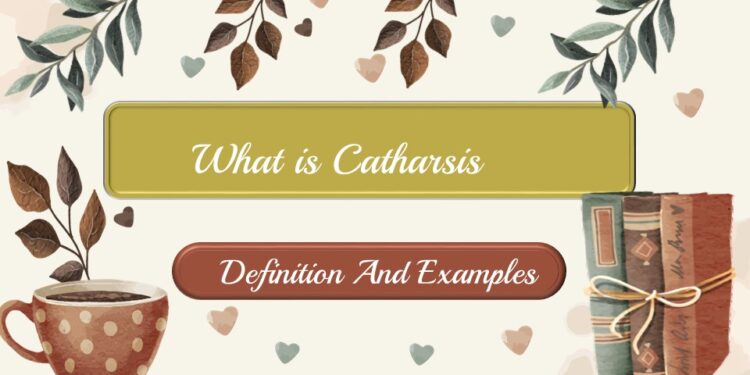What is Catharsis Definition And Examples
Catharsis is a concept rooted in ancient Greek literature and drama, referring to the emotional release or purging of strong emotions experienced by the audience through the observation of tragic events. The term “catharsis” is derived from the Greek word “katharsis,” meaning “cleansing” or “purification.” It was first introduced by Aristotle in his work “Poetics” to explain the impact of tragedy on spectators.
In the context of literature and drama, catharsis occurs when an audience engages deeply with a story or performance, experiencing a profound emotional transformation and achieving a sense of relief or purification. What is Catharsis Definition And Examples It involves the vicarious experiencing and subsequent purging of intense emotions, such as fear, pity, sorrow, or empathy, that are evoked by witnessing the struggles and suffering of fictional characters.
According to Aristotle, catharsis is the ultimate purpose of tragedy. What is Catharsis Definition And ExamplesHe argued that tragedy provides a safe and controlled space for audiences to confront and process their own fears, anxieties, and emotions by witnessing the tragic fate of the characters. What is Catharsis Definition And Examples By experiencing these emotions and undergoing a cathartic release, spectators could achieve a state of emotional equilibrium and cathartic purification.
Also Read-
- What is Bildungsroman Definition And Examples
- What is Cacophony Definition And Examples
- What is Assonance Definition And Examples
- What is Atmosphere Definition And Examples
Catharsis is not limited to tragedy alone but can also be found in other forms of literature, such as novels, poetry, or even in real-life situations. Any narrative that elicits intense emotions and allows the audience to empathize deeply with the characters’ experiences has the potential to facilitate a cathartic response.
The concept of catharsis has had a profound influence on literary theory and the understanding of the emotional power of art. What is Catharsis Definition And Examples It suggests that literature and drama play a crucial role in exploring and processing human emotions, providing a therapeutic function by allowing individuals to engage with and confront their own emotional complexities through fictional narratives.
Moreover, catharsis can serve as a means of fostering empathy and understanding. By experiencing a wide range of emotions through literature, readers can develop a deeper sense of empathy and compassion towards others, gaining insight into the human condition and expanding their emotional horizons.
However, it is important to note that the nature and interpretation of catharsis have been the subject of ongoing debate among scholars. What is Catharsis Definition And Examples While some argue that catharsis offers a transformative and healing experience, others question its effectiveness and suggest alternative interpretations of the emotional impact of literature.
Examples Of Catharsis
There are the some examples:-
- “Romeo and Juliet” by William Shakespeare: In Shakespeare’s tragic play, the deaths of the young lovers Romeo and Juliet elicit a strong emotional response from the audience. What is Catharsis Definition And Examples The tragic outcome of their forbidden love and the subsequent reconciliation of their feuding families creates a cathartic experience. The audience may feel a sense of release and emotional purging as they witness the intense love, loss, and ultimately the tragic consequences of the characters’ actions.
- “To Kill a Mockingbird” by Harper Lee: In Lee’s novel, the trial of Tom Robinson, a black man falsely accused of rape, invokes strong feelings of injustice, empathy, and moral outrage. As readers follow the story through the eyes of Scout, the young protagonist, they become emotionally invested in the fight against racism and prejudice. The ultimate tragedy of Tom Robinson’s fate and the triumph of compassion in the face of injustice can lead to a cathartic release of emotions for the readers.
- “Hamlet” by William Shakespeare: Shakespeare’s play “Hamlet” explores themes of grief, revenge, and existential angst. The emotional journey of the titular character, haunted by his father’s ghost and tormented by indecision, resonates with readers and spectators. What is Catharsis Definition And Examples The play’s tragic ending, with the death of numerous characters, allows the audience to experience a cathartic release of emotions, contemplating the complexities of life, mortality, and the consequences of one’s actions.
- “The Diary of Anne Frank” by Anne Frank: Anne Frank’s diary, documenting her experiences hiding from the Nazis during World War II, offers a poignant and emotional portrayal of a young girl’s hopes, fears, and struggles. What is Catharsis Definition And Examples The diary’s publication and subsequent reading by audiences around the world have evoked a cathartic response, allowing readers to connect with Anne’s humanity, empathize with her situation, and reflect on the atrocities of the Holocaust.
- “The Kite Runner” by Khaled Hosseini: Hosseini’s novel delves into themes of guilt, redemption, and the complex relationships between friends and family. What is Catharsis Definition And Examples The protagonist’s journey towards seeking forgiveness and finding redemption resonates strongly with readers. The emotional climax and resolution of the story provide a cathartic experience as the characters confront their past actions and strive for personal growth.
Conclusion
Catharsis is a powerful emotional experience that occurs when individuals engage deeply with literature or drama and undergo a purging or release of intense emotions. What is Catharsis Definition And Examples It allows the audience to confront their fears, anxieties, and emotions in a controlled environment, achieving a sense of emotional relief and purification. What is Catharsis Definition And Examples Catharsis plays a significant role in literature, enabling individuals to explore the depths of human experience, foster empathy, and gain insight into their own emotional complexities.
FAQ.
Q. Can catharsis occur in genres other than tragedy?
Ans. While catharsis is often associated with tragedy, it can occur in various genres. Any form of literature that elicits strong emotions and allows readers to deeply engage with the characters and their experiences has the potential to facilitate a cathartic response. This can include genres such as romance, historical fiction, coming-of-age stories, and more.
Q. Is catharsis a universal experience?
Ans. The potential for catharsis is a widely recognized aspect of human psychology, but the specific emotional responses and experiences may vary among individuals. Different people may have different emotional triggers and responses to literature based on their personal backgrounds, experiences, and emotional sensitivities.
Q. Can catharsis be therapeutic?
Ans. Catharsis in literature can provide a therapeutic effect by allowing individuals to explore and process their own emotions in a safe and controlled environment. Engaging with intense emotions through literature can offer a sense of release, understanding, and emotional healing. However, it is important to note that literature should not be seen as a substitute for professional therapy or mental health support when needed.
Q. Can catharsis lead to personal growth?
Ans. Yes, catharsis can contribute to personal growth by fostering self-reflection, empathy, and insight into one’s own emotions and experiences. Through literature, individuals can gain a deeper understanding of themselves and others, challenge their perspectives, and develop emotional resilience and maturity.
Q. Is catharsis limited to literature?
Ans. No, catharsis can occur in various art forms beyond literature, such as film, theater, music, and visual arts. Any artistic expression that elicits strong emotional responses and offers a transformative experience has the potential to evoke catharsis.
















